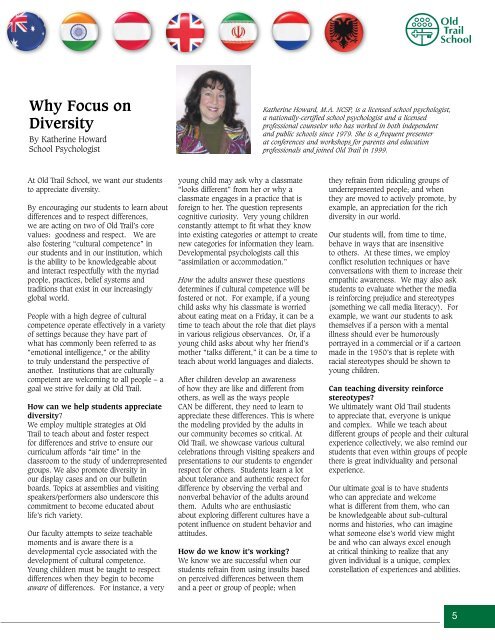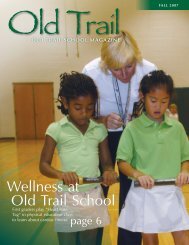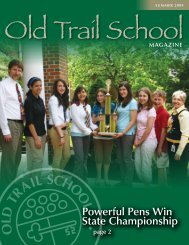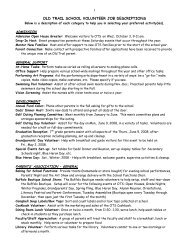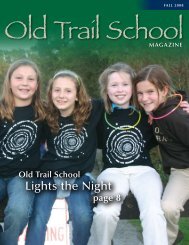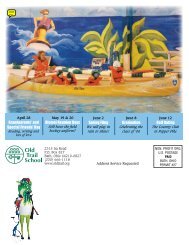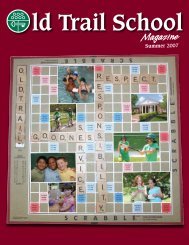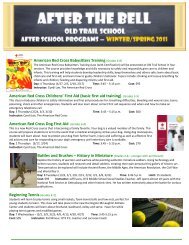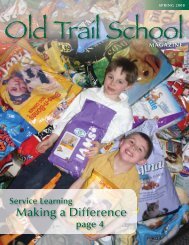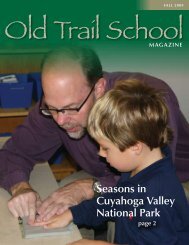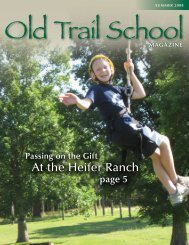Create successful ePaper yourself
Turn your PDF publications into a flip-book with our unique Google optimized e-Paper software.
Why Focus onDiversityBy Katherine Howard<strong>School</strong> PsychologistKatherine Howard, M.A. NCSP, is a licensed school psychologist,a nationally-certified school psychologist and a licensedprofessional counselor who has worked in both independentand public schools since 1979. She is a frequent presenterat conferences and workshops for parents and educationprofessionals and joined <strong>Old</strong> <strong>Trail</strong> in 1999.At <strong>Old</strong> <strong>Trail</strong> <strong>School</strong>, we want our studentsto appreciate diversity.By encouraging our students to learn aboutdifferences and to respect differences,we are acting on two of <strong>Old</strong> <strong>Trail</strong>’s corevalues: goodness and respect. We arealso fostering “cultural competence” inour students and in our institution, whichis the ability to be knowledgeable aboutand interact respectfully with the myriadpeople, practices, belief systems andtraditions that exist in our increasinglyglobal world.People with a high degree of culturalcompetence operate effectively in a varietyof settings because they have part ofwhat has commonly been referred to as“emotional intelligence,” or the abilityto truly understand the perspective ofanother. Institutions that are culturallycompetent are welcoming to all people – agoal we strive for daily at <strong>Old</strong> <strong>Trail</strong>.How can we help students appreciatediversity?We employ multiple strategies at <strong>Old</strong><strong>Trail</strong> to teach about and foster respectfor differences and strive to ensure ourcurriculum affords “air time” in theclassroom to the study of underrepresentedgroups. We also promote diversity inour display cases and on our bulletinboards. Topics at assemblies and visitingspeakers/performers also underscore thiscommitment to become educated aboutlife’s rich variety.Our faculty attempts to seize teachablemoments and is aware there is adevelopmental cycle associated with thedevelopment of cultural competence.Young children must be taught to respectdifferences when they begin to becomeaware of differences. For instance, a veryyoung child may ask why a classmate“looks different” from her or why aclassmate engages in a practice that isforeign to her. The question representscognitive curiosity. Very young childrenconstantly attempt to fit what they knowinto existing categories or attempt to createnew categories for information they learn.Developmental psychologists call this“assimilation or accommodation.”How the adults answer these questionsdetermines if cultural competence will befostered or not. For example, if a youngchild asks why his classmate is worriedabout eating meat on a Friday, it can be atime to teach about the role that diet playsin various religious observances. Or, if ayoung child asks about why her friend’smother “talks different,” it can be a time toteach about world languages and dialects.After children develop an awarenessof how they are like and different fromothers, as well as the ways peopleCAN be different, they need to learn toappreciate these differences. This is wherethe modeling provided by the adults inour community becomes so critical. At<strong>Old</strong> <strong>Trail</strong>, we showcase various culturalcelebrations through visiting speakers andpresentations to our students to engenderrespect for others. Students learn a lotabout tolerance and authentic respect fordifference by observing the verbal andnonverbal behavior of the adults aroundthem. Adults who are enthusiasticabout exploring different cultures have apotent influence on student behavior andattitudes.How do we know it’s working?We know we are successful when ourstudents refrain from using insults basedon perceived differences between themand a peer or group of people; whenthey refrain from ridiculing groups ofunderrepresented people; and whenthey are moved to actively promote, byexample, an appreciation for the richdiversity in our world.Our students will, from time to time,behave in ways that are insensitiveto others. At these times, we employconflict resolution techniques or haveconversations with them to increase theirempathic awareness. We may also askstudents to evaluate whether the mediais reinforcing prejudice and stereotypes(something we call media literacy). Forexample, we want our students to askthemselves if a person with a mentalillness should ever be humorouslyportrayed in a commercial or if a cartoonmade in the 1950’s that is replete withracial stereotypes should be shown toyoung children.Can teaching diversity reinforcestereotypes?We ultimately want <strong>Old</strong> <strong>Trail</strong> studentsto appreciate that, everyone is uniqueand complex. While we teach aboutdifferent groups of people and their culturalexperience collectively, we also remind ourstudents that even within groups of peoplethere is great individuality and personalexperience.Our ultimate goal is to have studentswho can appreciate and welcomewhat is different from them, who canbe knowledgeable about sub-culturalnorms and histories, who can imaginewhat someone else’s world view mightbe and who can always excel enoughat critical thinking to realize that anygiven individual is a unique, complexconstellation of experiences and abilities.5


